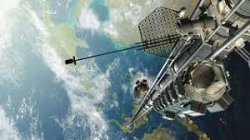JimBowie1958
Old Fogey
- Sep 25, 2011
- 63,590
- 16,753
- 2,220
The Colonization of our solar system is very feasible and one day I think most human beings will live in space instead of on Earth. The key is allowing private corporations to do most of the heavy lifting, so to speak, while governments will regulate and supervise what is done instead of managing it for everyone.
So here are some rough ideas I have on four distinct phases to the exploration of our Solar System and its development.
We are now in Phase 1, basically establishing a presence in Earth orbit. This phase is marked by the high cost of getting out of Earth orbit, but that does not mean that there is no profitability to doing so.
The potential profitability of this phase is lies in the following:
Any productive responses are appreciated.
So here are some rough ideas I have on four distinct phases to the exploration of our Solar System and its development.
We are now in Phase 1, basically establishing a presence in Earth orbit. This phase is marked by the high cost of getting out of Earth orbit, but that does not mean that there is no profitability to doing so.
The potential profitability of this phase is lies in the following:
- Space tourism - wealthy people will pay serious money to go into low Earth orbit and see the stars unfiltered by our atmosphere. Early efforts toward building low Earth orbit vacation stations are very plausible.
- Space manufacturing -
- perfectly spherical ceramic ball bearings to make molds from on Earth
- 3D printing that exploits the zero gravity for unique production.
- telecommunications across the planet; internet literally available on every spot of the Earth and cheap.
- Military contracts - obvious benefits.
- Cleaning up debris from orbital 'accidents' will be profitable. Just build mobile satellites that can deflect crap into re-entry where they will burn up in the atmosphere. They would be approached from behind to decrease impact and built very solid with Tungsten carbide tile shells and have replaceable tiles.
- Private exploration and prospecting of the Solar System will grow quickly as laws pertaining to mineral rights and claims are firmly affixed and initiate commercial mining operation planning and execution with robots and other forms of unmanned exploration and testing.
- Space tourism will explode with activity and tours to the moon and large vacation stations will be like luxury tourist sites on Earth.
- Space manufacturing will expand more quickly as we develop early moon bases that will harvest minerals on the Moon to use in colonization efforts and building space construction facilities. Early space vessel prototypes will be manufactured and sold to corporations to further prospect the moon, Mars and the Asteroid belt.
- Military and policing contracts to oversee space activity among the nations involved will be an ever growing source of revenue. Nations involved in space exploration and development will number in the dozens and be from every continent.
- Space reclamation of metal parts, debris and lost vessels will grow into a major industry, in further efforts to reduce the likelihood of space collision.
- Unmanned posts on Mars, the moon, and larger asteroids will be created. These will be automated repair facilities and testing stations for mineral composition of samples returned by unmanned drones.
- Permanent Moon vacation spots will be built, and most of the earlier vacation stations repurposed into manufacturing stations.
- Early, simpler O'Neil colonies that will evolve the technology and be mostly manned stations that produce high demand items like space adapted alloys, robots and ships. These will be austere and functional, but greatly reduce costs of space manufacture.
- Early mining of the asteroid belt will have to be tightly regulated to allow the economy on Earth to adapt. Too much too soon will see a huge collapse in the markets of many commodities that are rare on Earth but possibly abundant in space, like gold, platinum and other precious metals and gem stones, and fuels like Uranium and Thorium.
- other industries from Phase 2 will grow exponentially.
- The commercial exploitation in this phase will resemble the earlier phases except that O'Neil colonies will become primarily vacation destinations and permanent space colonies that will be Utopian and have ideal environments. Some zero Gravity production will take place in their core areas, but mostly the purpose of these colonies will be to house people and be HQ to corporate interests, not production itself so much.
Any productive responses are appreciated.


